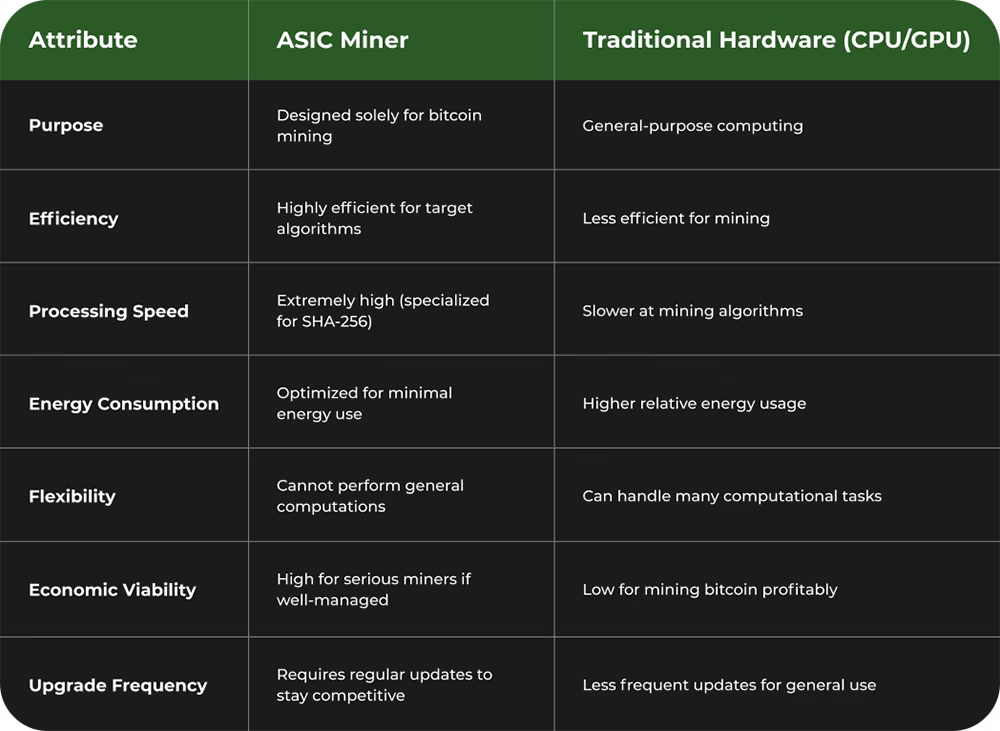Specialized machines are shaping the future of bitcoin and cryptocurrency networks. These ASIC miners are built to solve the most complex mathematical problems out there and their top models can rake in potential annual revenues of hundreds of thousands of dollars for serious miners. You might expect the real innovation to be all about speed and processing power but the actual breakthrough is how these devices have turned the mining game into a race of energy efficiency and purpose-built design.

An ASIC miner, which stands for Application-Specific Integrated Circuit, represents a specialized computer hardware device engineered exclusively for bitcoin mining. Unlike general-purpose computing hardware, ASIC miners are precision-designed to perform one specific computational task with maximum efficiency: solving complex mathematical algorithms required to validate bitcoin transactions and earn mining rewards.
ASIC miners differ fundamentally from traditional computer processors by being purpose-built for cryptocurrency mining. These devices contain chips meticulously engineered to execute bitcoin’s SHA-256 hashing algorithm with unprecedented speed and energy efficiency. Where standard computer processors might take significant time and electricity to solve complex cryptographic puzzles, an ASIC miner can complete these calculations exponentially faster.
The core design philosophy behind ASIC miners revolves around optimization. By eliminating unnecessary computational capabilities and focusing solely on bitcoin mining calculations, manufacturers can create machines that deliver extraordinary processing power while consuming relatively minimal electricity.

Learn more about advanced mining hardware in our comprehensive mining metrics guide.
According to blockchain research from CoinDesk, the most advanced ASIC miners can generate hundreds of thousands of dollars in potential annual revenue, though actual returns vary dramatically based on market conditions. Professional bitcoin miners continually evaluate and upgrade their hardware to maintain competitive mining capabilities in an increasingly sophisticated technological landscape.
ASIC miners play a pivotal role in maintaining the security, decentralization, and operational integrity of cryptocurrency networks, particularly bitcoin. These specialized machines are not merely hardware components but critical infrastructure that enables the blockchain ecosystem to function transparently and securely.
In cryptocurrency networks, ASIC miners serve as the fundamental mechanism for validating transactions and maintaining blockchain integrity. Through a process called proof of work, these devices solve complex mathematical problems that verify and record transactions on the blockchain.
Each solved calculation adds a new block to the chain, creating an immutable and transparent record that prevents double-spending and protects against potential fraudulent activities. Discover more about bitcoin mining fundamentals in our comprehensive guide..
The economic model of cryptocurrency mining is designed to incentivize participation while maintaining network security. Miners are rewarded with newly minted cryptocurrency tokens for their computational work, creating a self-sustaining ecosystem that attracts global participants. This distributed mining approach ensures that no single entity can monopolize transaction validation, preserving the decentralized nature of blockchain networks.
According to research from CoinShares, ASIC miners have become increasingly sophisticated, with modern machines representing significant technological investments that balance computational power, energy efficiency, and potential economic returns. The continuous evolution of ASIC technology reflects the dynamic and innovative nature of cryptocurrency mining.
ASIC miners function through a sophisticated process of computational problem-solving that transforms electrical input into blockchain validation. These specialized devices execute complex mathematical calculations with extraordinary precision, representing a technological marvel in digital currency infrastructure.
At the core of ASIC mining technology are custom-designed integrated circuits engineered exclusively for solving cryptographic hash functions. Unlike general-purpose processors, these chips eliminate unnecessary computational pathways, focusing exclusively on executing the SHA-256 algorithm used in bitcoin mining. Parallel processing becomes the fundamental mechanism, allowing multiple computational units to work simultaneously on different segments of cryptographic challenges. Learn more about advanced mining techniques in our comprehensive Bitcoin Mining 101 guide.
The operational workflow of an ASIC miner involves perpetually generating random numbers and applying them to a cryptographic hash function. Miners compete to find a specific numeric value called a nonce that, when combined with block data, produces a hash meeting predetermined network difficulty requirements. This process requires immense computational power and represents a probabilistic search where success is measured by statistical likelihood rather than guaranteed outcomes.
Key technological characteristics of ASIC miners include:
According to research from the MIT Digital Currency Initiative, ASIC miners have revolutionized cryptocurrency mining by transforming it from a hobbyist activity into a sophisticated technological enterprise. The continuous refinement of these devices demonstrates an ongoing technological arms race where incremental improvements in computational efficiency translate directly into economic advantages for miners.
Bitcoin mining represents a complex technological ecosystem where specialized hardware and cryptographic principles converge to maintain network security and transaction validation. Understanding the fundamental mechanics behind this process requires deep exploration of interconnected technological and economic concepts.
Proof of work stands as the foundational principle driving bitcoin mining, creating a decentralized consensus mechanism that ensures network integrity without relying on centralized authorities. ASIC miners play a critical role in this process by solving complex mathematical puzzles that validate transaction blocks. Each successful calculation adds a new block to the blockchain, requiring immense computational power and creating an economically secure method of transaction verification. Explore the intricacies of bitcoin mining economics in our comprehensive guide.
Two interconnected technical concepts define the operational landscape of bitcoin mining: hash rate and network difficulty. Hash rate represents the total computational power dedicated to mining, measured in calculations per second, while network difficulty dynamically adjusts to maintain consistent block generation times. As more miners join the network, the computational complexity increases, requiring more sophisticated ASIC hardware to remain competitive.
Key technical considerations in bitcoin mining include:
According to research from CoinMetrics, the relationship between hash rate, network difficulty, and mining profitability creates a complex adaptive system. Professional miners must constantly evaluate technological investments, electricity costs, and potential rewards to maintain operational effectiveness in an increasingly competitive environment.
Here is a table summarizing the key technical and economic factors that impact the profitability and operational effectiveness of ASIC mining, as reflected in the article.


Learning about ASIC miners shows how critical efficiency, up-to-date technology, and ROI calculations are for anyone serious about Bitcoin mining. Many readers quickly become overwhelmed by high hardware costs, complex setup, electricity expenses, and the ever-changing network difficulty. You need more than market knowledge—you need a partner who handles these barriers for you.
Now is the time to stop letting those challenges slow you down. Let Blockware Solutions help you start mining with confidence. Our hosted miners, expert analytics, and full-service Mining-as-a-Service platform break down every barrier to entry. Discover instant hardware deployment, on-demand support, and solutions that grow with you. Visit our homepage to launch your mining operation today and finally get the power and consistency you need to succeed.
What is an ASIC miner?
An ASIC miner, or Application-Specific Integrated Circuit miner, is a specialized hardware device designed specifically for bitcoin mining. Unlike general-purpose computers, ASIC miners are optimized to efficiently solve the complex mathematical algorithms required for validating bitcoin transactions.
How do ASIC miners differ from traditional mining hardware?
ASIC miners are purpose-built for a single task—bitcoin mining—whereas traditional hardware like CPUs and GPUs can handle a variety of computing tasks.
Below is a comparison table outlining the key differences between ASIC miners and traditional mining hardware, highlighting their core characteristics as discussed in the article.

The economic viability of ASIC miners depends on several critical factors including the initial cost of the hardware, electricity consumption rates, the current difficulty level of the bitcoin network, and the potential mining rewards that can be earned.
ASIC miners validate transactions and maintain blockchain integrity through a process called proof of work. They solve complex mathematical problems that prevent double-spending and ensure that every transaction is properly recorded on the blockchain.